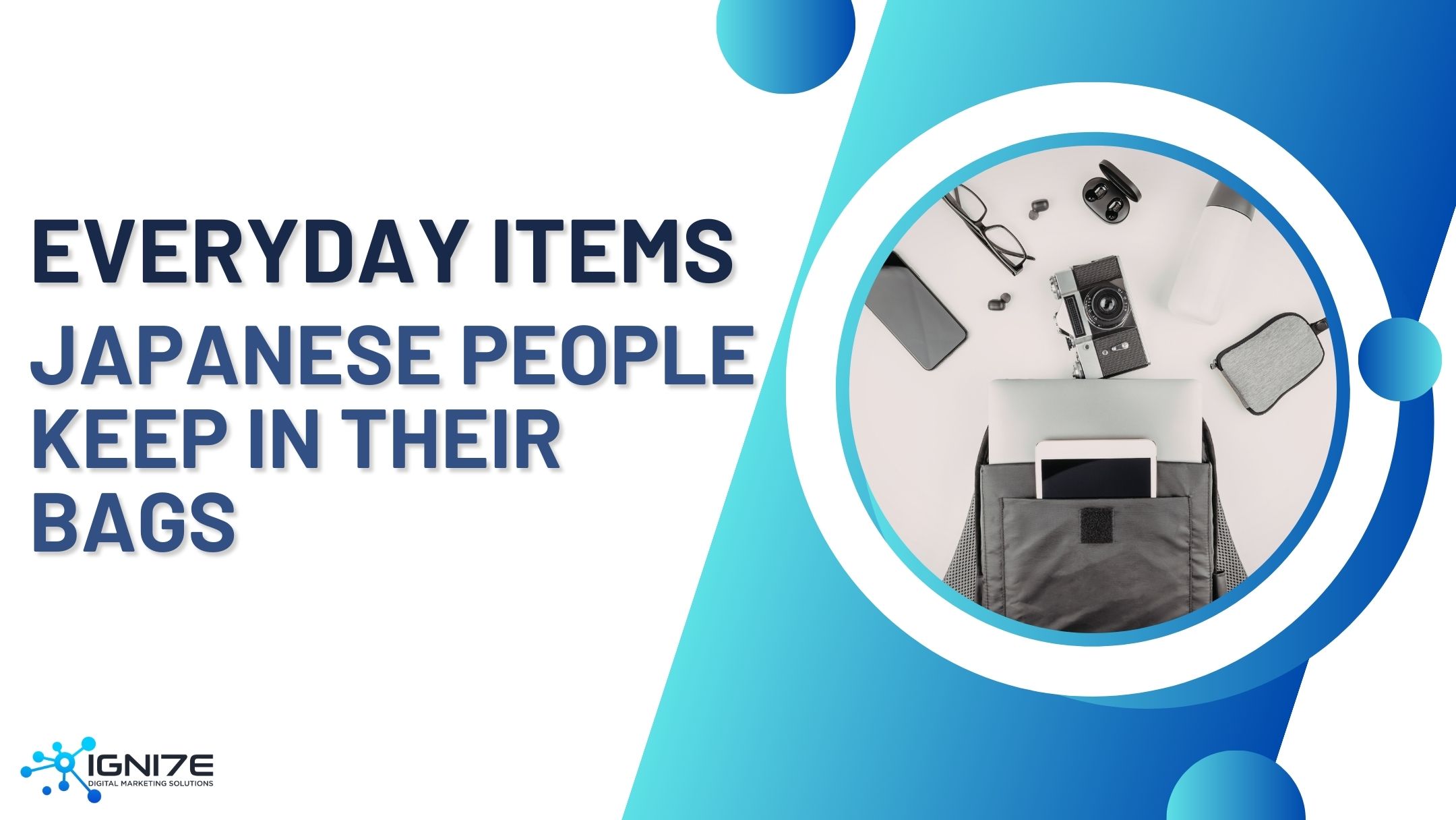A Guide to E-Commerce in Japan: Market Insights, Key Platforms, and Trends

Japan is the fourth largest e-commerce market in the world, making it an attractive yet complex destination for international businesses. With a population that is both digitally connected and culturally discerning, the opportunities in Japan are substantial—but so are the challenges.
From payment preferences and mobile-first behaviors to the deep cultural emphasis on customer service and trust, the Japanese e-commerce landscape operates by its own rules. Businesses that fail to localize will struggle, while those that adapt can tap into a loyal and high-value consumer base.
This guide breaks down everything you need to know: how the market works, where Japanese consumers shop, what they buy, which platforms dominate, and what trends are shaping the future. Whether you're new to Japan or seeking to refine your strategy, this resource will help you create a roadmap to success.
Understanding E-Commerce in Japan
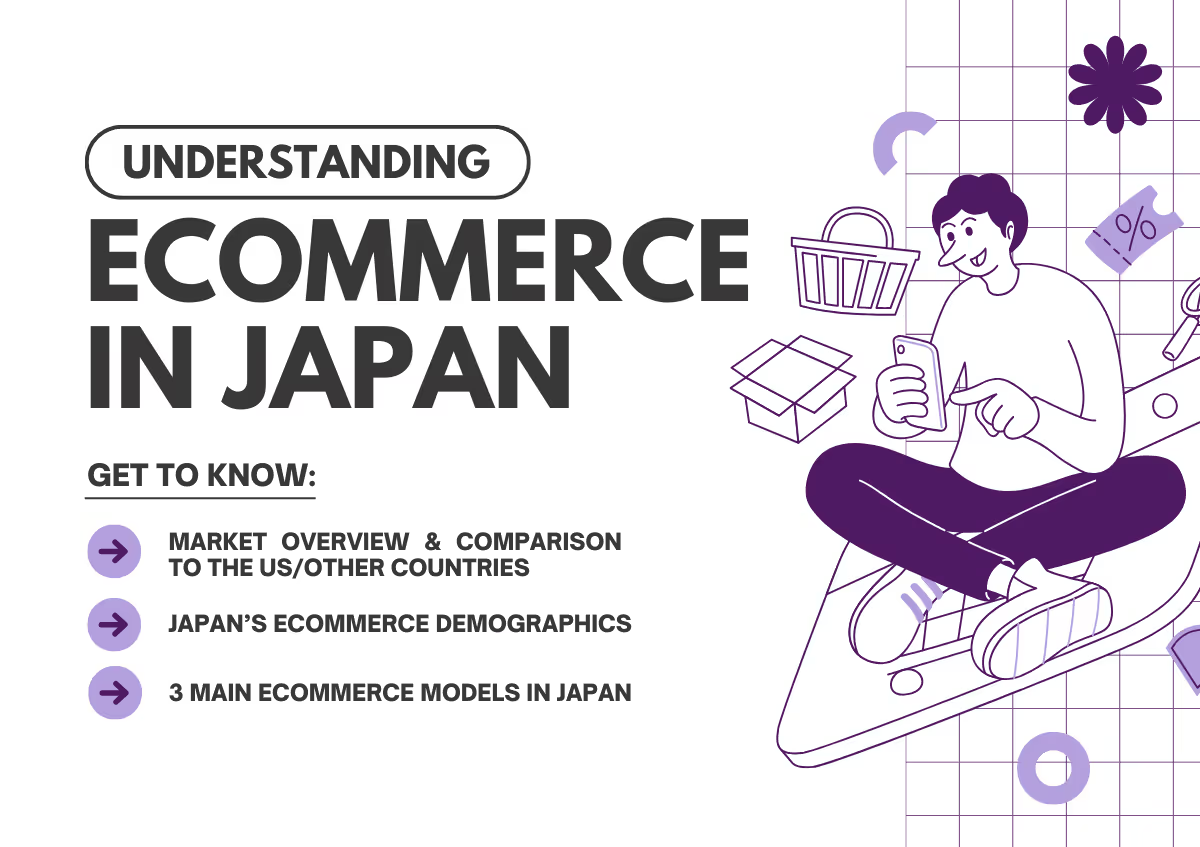
Japan’s e-commerce market is one of the most dynamic and distinctive in the world. While it offers tremendous potential for international businesses, succeeding here requires more than just translating a website or setting up logistics. To thrive, companies must understand Japan’s unique consumer culture, e-commerce infrastructure, and shopping behaviors.
Market Overview & Comparison to the US/Other Countries
Japan’s digital commerce sphere has seen significant expansion over the past decade, underpinned by the country’s emphasis on quality, meticulous service, and technological innovation. Today, Japan ranks as the world’s fourth-largest e-commerce market, with online shopping becoming an integral part of everyday life.
However, Japan’s e-commerce landscape differs from Western markets in several key ways:
Since 2023, over 53% of Japanese households with two or more members regularly shop online. This figure is steadily rising, driven by factors such as:
- An aging population increasingly comfortable with online shopping.
- The widespread adoption of cashless payments.
- The growing influence of social media on consumer decisions—especially among younger generations.
Japanese shoppers typically spend around $135 per month on online purchases and make two to three online purchases per month. The market is led by major players such as Amazon Japan, Rakuten, and Yahoo! Shopping, but second-hand marketplaces like Mercari and Yahoo! Auctions also play a significant role due to Japan’s strong culture of thrift and reuse.
Fast delivery is not just a perk but an expectation in Japan, with many orders arriving on the same day. This high bar for logistics and service reflects Japan’s customer-first culture, making reliability and attention to detail critical for foreign companies.
Japan’s E-Commerce Demographics
Understanding who shops online in Japan—and how they do so—is essential for crafting an effective market entry strategy. The following table outlines the age distribution of online shoppers:
Key demographic insights:
- The 30–59 age group accounts for the majority of online spending, particularly for higher-ticket items.
Older generations are increasingly adopting e-commerce, especially for categories like health products, household goods, and hobbies.
- Younger generations (especially Gen Z) are more likely to make impulsive purchases, influenced by social media trends and peer recommendations.
For brands targeting Japan, it is essential to balance strategies that appeal to tech-savvy youth while also accommodating older, quality-conscious consumers.
The Three Main E-Commerce Models in Japan
- Using Major Platforms (Amazon Japan, Rakuten, Yahoo! Shopping)
The majority of online sales in Japan happen through established marketplaces:
Pros:
- Instant access to a large, trust-based customer base.
- Built-in logistics, payment systems, and promotional events (e.g., Rakuten’s Super Sale).
Cons:
- Platform fees can eat into margins.
- Less brand control compared to operating an independent site.
Notable platforms:
- Amazon Japan: Fast delivery, reliable service, and Prime loyalty.
- Rakuten: Strong point-based loyalty ecosystem and small business support.
- Yahoo! Shopping & PayPay Mall: Popular for daily necessities and tied to Japan’s top mobile wallet, PayPay.
- Running Your Own Online Store (自社サイト / Jisha Site)
- Many Japanese and foreign brands operate their own official e-commerce sites to retain complete control over brand image, customer data, and profit margins.
Pros:
- Complete control over design, UX, pricing, and customer relationships.
- Opportunity to build brand loyalty and recurring sales.
Cons:
- Requires more investment in traffic generation, digital marketing, and fulfillment.
- Trust-building is essential—new brands face skepticism without a strong reputation.
- Many 自社サイト link with an official LINE account for direct communication, promotions, and customer engagement, which can function similarly to email campaigns in the West.
- Social Commerce & Alternative Models (LINE, Instagram, Live Commerce)
Social commerce is gaining traction, particularly in fashion, beauty, and lifestyle sectors:
Key Channels:
- LINE Shopping & LINE Official Accounts: Used for sending coupons, announcements, and driving repeat business.
- Instagram Shopping & Live Commerce: Especially popular with younger consumers for impulse and trend-driven purchases.
- Mercari & Other C2C Platforms: Growing for second-hand goods and niche items.
This model often complements marketplace or self-run stores, providing additional traffic and brand exposure.
For international businesses, it’s often wise to begin with a major platform (e.g., Amazon or Rakuten) to establish brand awareness, while gradually developing your own online store and social commerce presence. Local payment options, fast shipping from within Japan, and personalized customer service in Japanese are non-negotiables for success.
Strategic Essentials for E-Commerce Success in Japan
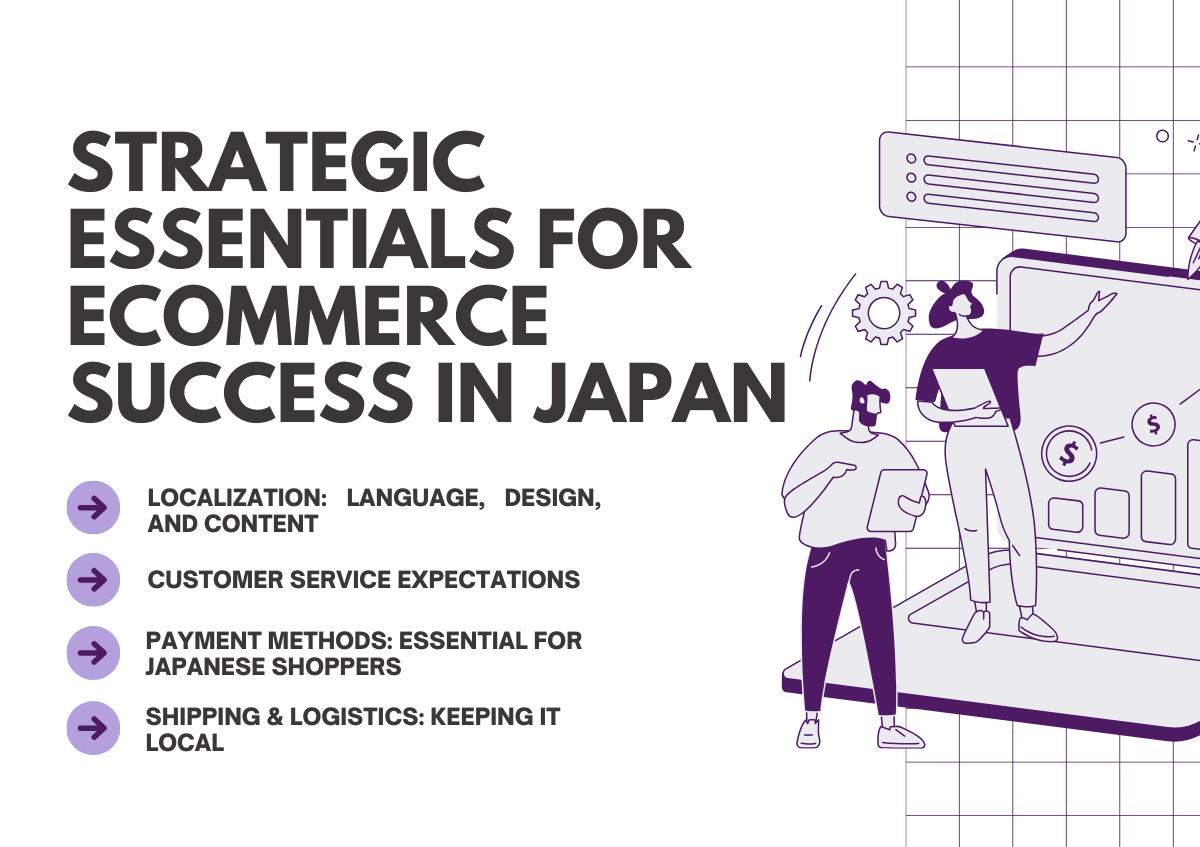
Japan offers speedy delivery, exclusive media content, and shopping perks—all adapted to local tastes.
Breaking into Japan’s e-commerce market requires more than just a translated website and international shipping. To succeed, overseas businesses must align their offerings with Japanese cultural expectations, consumer behaviors, and digital habits. Below are the four critical factors every brand must master to thrive in Japan’s competitive online retail environment.
Localization: Language, Design, and Content
Localization in Japan extends far beyond language—it’s about tailoring your entire customer experience to local expectations.
- Japanese-Language Website is Non-Negotiable:
A fully localized website in Japanese is essential. Automatic translation tools or English-only sites are often viewed as unprofessional or unreliable by Japanese consumers.
- Clean, Informative Design:
Japanese e-commerce sites tend to be more text-heavy than Western counterparts, often packed with detailed product descriptions, multiple images, and specifications. This aligns with the Japanese tendency to research thoroughly before making a purchase. Clean navigation, clear pricing, and visible trust signals (like review ratings) are must-haves.
- Tailored Product Offerings:
Localization also applies to what you sell. For example, IKEA initially struggled in Japan until they adapted their product lines to smaller living spaces. Similarly, KitKat’s Japan-exclusive flavors, such as matcha and sakura, have made the brand wildly popular. Understanding Japan’s urban living, compact spaces, and cultural preferences can help you fine-tune your offering.
- Mobile-First Mindset:
Japanese consumers spend a significant amount of time commuting and shopping via smartphones. Your mobile experience must be smooth, fast, and fully functional.
Be sure to regularly update your website for seasonal promotions (e.g., sakura season, summer gifts, New Year) as Japanese shoppers are highly responsive to seasonal marketing.
Customer Service Expectations
Japan is known globally for its exceptional customer service, and e-commerce is no exception. The standards here are significantly higher than in most Western markets.
- Fast, Polite Responses:
Japanese shoppers expect quick replies and polite, formal communication in Japanese. Even minor issues can damage trust if not handled with care and efficiency.
- Local Customer Support is Essential:
Having a Japanese call center or a trusted local partner to handle inquiries is often necessary, especially for higher-value products. Automated replies or English-only support will almost certainly alienate your audience.
- Returns & Refunds:
A clear and fair return policy in Japanese builds trust. Japanese consumers are meticulous and risk-averse; transparency in this area can help convert hesitant shoppers.
Customer reviews carry enormous weight in Japan. Proactively request feedback and handle negative reviews with delicacy and promptness.
Payment Methods: Essential for Japanese Shoppers
Offering the right payment options can make or break your e-commerce success in Japan.
- Common Payment Methods to Offer:
- Installments & After-Pay:
For expensive items (electronics, luxury goods), offering installment plans or Buy Now Pay Later (BNPL) can significantly boost conversions. This typically requires collaboration with local payment processors and establishing a Japanese legal entity.
- Security & Trust:
Payment security is a top concern for Japanese consumers, especially when trying new or foreign brands. Digital wallets like PayPay also help reassure first-time buyers.
Shipping & Logistics: Keeping It Local
Fast and reliable shipping is among the most critical factors for success in Japan’s e-commerce market. Thanks to Amazon Japan Prime, same-day or next-day delivery has become the norm—anything slower can lead to abandoned carts.
- Domestic Fulfillment:
Whenever possible, store and ship products from within Japan. Relying on overseas fulfillment can dramatically reduce your conversion rate due to longer shipping times and higher costs.
- Convenience Store Pickup:
Offering pick-up at convenience stores (7-Eleven, Lawson, FamilyMart) is a popular option in Japan and adds flexibility for customers.
- Meticulous Packaging:
Packaging presentation matters in Japan—poor packaging can lead to negative reviews, even if the product is of high quality. This is particularly important for gift items or premium goods.
- Transparent Shipping Policies:
Communicate shipping costs, delivery times, and return processes in Japanese. Surprises at checkout are one of the fastest ways to lose trust.
Partnering with local logistics providers (Yamato, Sagawa, Japan Post) can ensure fast delivery and tapping into the country's extremely efficient courier network.
Key Success Factors for E-Commerce in Japan
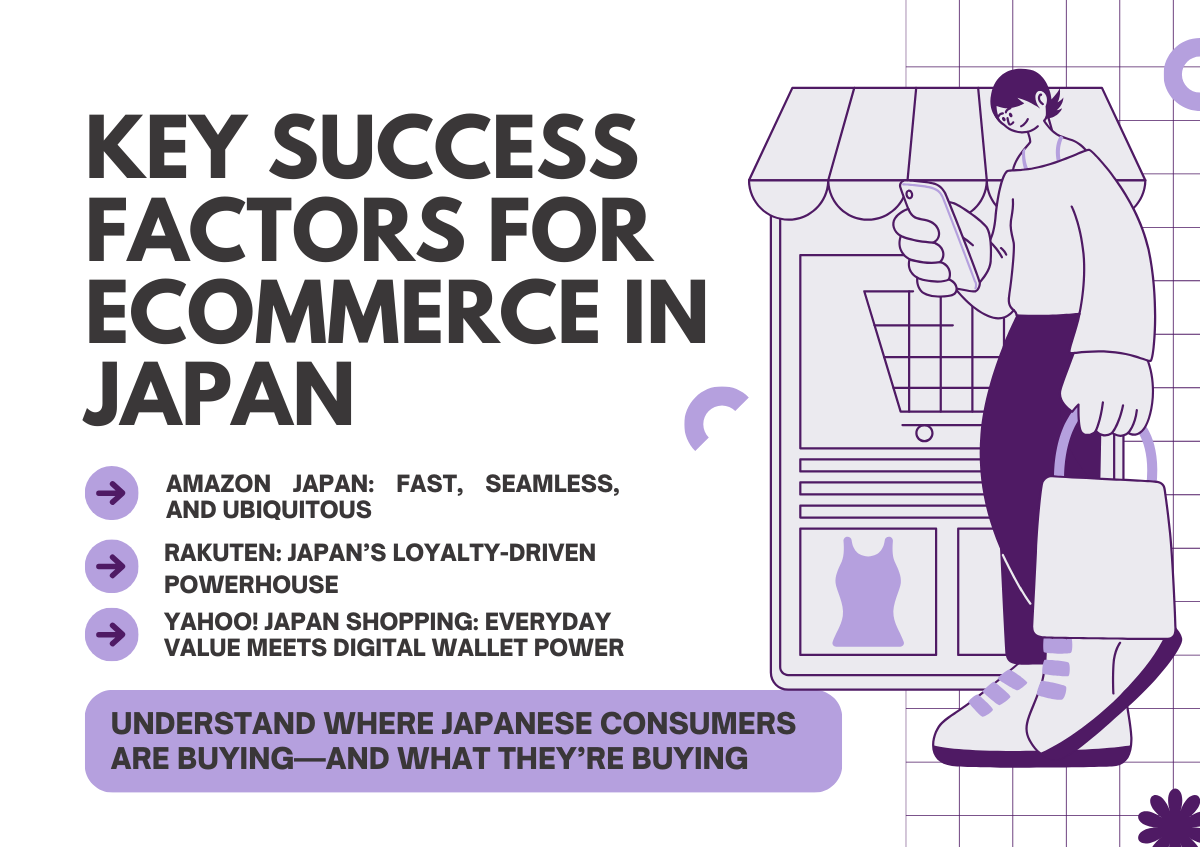
Japan’s e-commerce ecosystem is largely dominated by a handful of trusted, integrated platforms that cater to its mobile-first, urban-dwelling population. For international businesses entering this market, understanding how each of these platforms functions—and why Japanese consumers gravitate toward them—is essential for deciding where to launch and how to scale.
As of 2023, Amazon Japan and Rakuten together account for over 80% of the Japanese e-commerce market, with others like Yahoo! Shopping and Mercari providing specialized value.
Amazon Japan: Fast, Seamless, and Ubiquitous

Source: Amazon Homepage
Amazon Japan has steadily risen to become the top e-commerce platform in Japan, with a market share of around 49.6% (as of June 2024) and the highest user preference among online shoppers.
Amazon’s strengths in logistics, customer service, and convenience align perfectly with Japanese expectations, particularly among mobile users and working professionals. Its fast, reliable delivery has set the bar for shipping speed in Japan—same-day or next-day delivery is now considered standard.
Key Differentiators:
- Amazon Prime Japan offers speedy delivery, exclusive media content, and shopping perks—all adapted to local tastes.
- Mobile-Optimized Experience: With a population that commutes for over an hour daily and prefers shopping on smartphones, Amazon Japan provides a sleek and efficient mobile user experience.
- Product Mix Reflects Local Demand: Unlike Amazon US, top sellers in Japan include cosmetics, luxury umbrellas, skincare, and household gadgets—items that reflect Japan’s quality-conscious and practical consumer base.
English-language listings are technically available through machine translation, but sellers who fully localize their listings and customer service in Japanese gain a significant advantage.
Amazon Japan is the go-to platform for brands seeking to establish scale, speed, and a cross-category presence.
Rakuten: Japan’s Loyalty-Driven Powerhouse
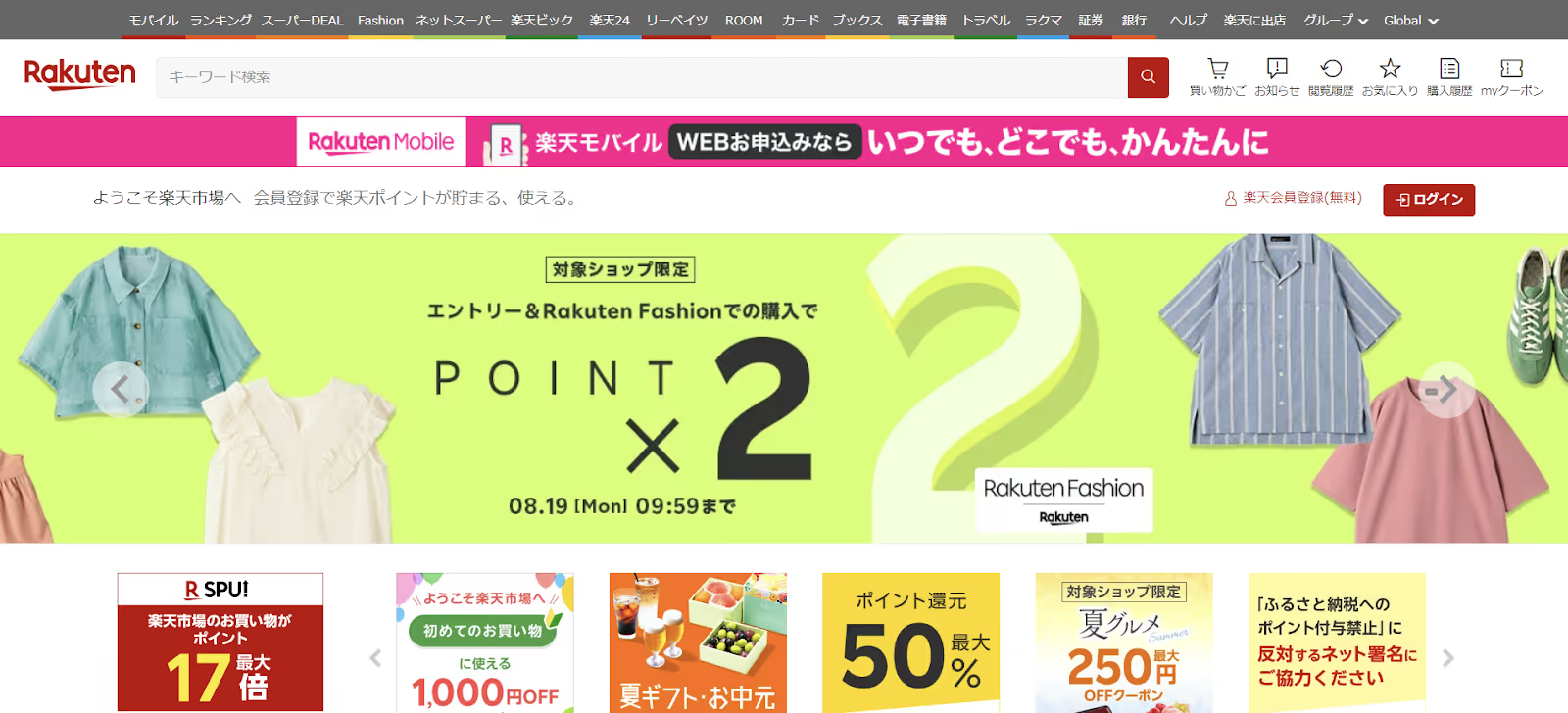
Source: Rakuten Homepage
Founded in 1997 by Hiroshi Mikitani, Rakuten is more than an e-commerce platform—it's an entire digital ecosystem. From Rakuten Bank to Rakuten Travel, Rakuten Mobile, and Rakuten Insurance, the brand has become deeply embedded in the daily lives of Japanese consumers.
What sets Rakuten apart is its highly successful loyalty and gamification system. Through the Rakuten Super Points program, users earn points not just from shopping but also from using affiliated services. These points can be redeemed both online and offline at over 700,000 partner locations, including convenience stores, restaurants, and supermarkets.
Why Rakuten Works in Japan:
- Points Matter: More than 60% of Japanese users participate in Rakuten’s loyalty program, making it the most-used point-based reward system in the country.
- Strong Brand Trust: Rakuten is a homegrown brand, and Japanese consumers often favor domestic companies that offer reliability and support.
- Wide Product Range: From fashion to electronics and groceries, Rakuten offers a deep inventory across all popular e-commerce categories.
- Localized UX: Rakuten’s website adheres to Japan’s preferred web aesthetic—characterized by information-rich, feature-heavy content and numerous promotions.
Although it holds approximately 32.4% of the market (as of June 2024), down from past highs due to Amazon’s growing presence, Rakuten remains essential for brands that want to tap into the loyalty-driven, domestic-focused segment of the Japanese e-commerce market.
Yahoo! Japan Shopping: Everyday Value Meets Digital Wallet Power

Source: Yahoo! Japan Homepage
Yahoo! Japan remains one of Japan’s most recognizable digital brands. It has maintained its relevance in e-commerce through strategic integrations—most notably, the merger of Yahoo! Shopping with PayPay Mall, Japan’s fastest-growing digital wallet platform.
This integration allows customers to earn and redeem PayPay points, similar to Rakuten’s ecosystem. It has made Yahoo! Shopping particularly attractive to price-conscious shoppers and those who actively use PayPay for daily purchases.
Platform Highlights:
- Category Strength: Yahoo! Shopping is strong in household items, electronics, health & beauty, and food.
- Auction Culture: Yahoo! Auctions is still Japan’s largest online auction marketplace, ideal for buying and selling rare or used items.
- Mobile-Friendly & Value-Driven: Many users turn to Yahoo! Shopping for its promotional deals, flash sales, and digital wallet rewards.
While it holds a smaller share of the market compared to Amazon and Rakuten, Yahoo! Shopping is still among the top ten global e-commerce platforms by traffic, offering brands additional visibility—especially for budget-sensitive or second-hand product categories.
Other Notable Platforms
Mercari: The Peer-to-Peer Giant
- Japan’s leading C2C (consumer-to-consumer) marketplace.
- Particularly popular among younger shoppers and sustainability-conscious consumers.
- Enables users to ship items via anonymous drop-offs at convenience stores, a feature that seamlessly integrates into Japan’s 24/7 convenience store culture.
- An excellent space for resale, refurbished products, and circular economy brands.
Qoo10 Japan: Cross-Border Meets Local Niche
- Originally from Singapore and now owned by eBay, Qoo10 offers localized shopping for Japan.
- It’s especially popular among K-beauty, accessories, and trend-driven product categories.
- Currently focusing on TV ad campaigns to grow market share.
Where Japanese Consumers Are Buying—and What They’re Buying
Japan’s e-commerce consumers are digitally savvy, highly mobile, and deeply quality-conscious. While smartphones are the device of choice for most shoppers, their preferences span both modern digital experiences and traditional product categories—including physical media, high-end electronics, and fashion.
How Japanese Consumers Shop
- Smartphone-first behavior: Nearly 70% of Japanese consumers aged 20s to 40s rely solely on smartphones for online shopping.
- Urban lifestyle: With 93.5% of the population residing in urban areas and many facing daily commutes exceeding an hour, mobile convenience is crucial.
- Behavior snapshot (2023–2024):
- 81.6% searched online for a product or service
- 85.0% visited an online retail site
- 48.4% used a mobile shopping app
- 73.7% made a purchase online
- 32.1% purchased something in the past month
What Japanese Consumers Are Buying
Japanese consumers are renowned for their high standards in terms of durability, aesthetic value, and functionality. Their shopping habits reflect a blend of high-tech enthusiasm and cultural appreciation for tangible, well-crafted goods.
2022–2023: Product Categories by Annual Spending
- Fashion Reigns Supreme:
Fashion is the top category among Japanese consumers. This isn’t just about volume—it reflects Japan’s unique style culture. Tokyo is a global fashion epicenter, and consumers are particularly drawn to well-made, tasteful apparel. Foreign brands that adapt their sizing, offer Japan-exclusive collections, or prioritize high-quality materials can establish a loyal following.
- Electronics Are Highly Prized—but Pricey:
Electronics are essential in Japan’s tech-forward society, but they often come with premium price tags. A weak yen, offshored manufacturing, and tariffs contribute to high domestic prices, creating a strong opportunity for competitive overseas sellers offering genuine, high-quality technology.
- Home Goods & DIY See Continued Growth:
COVID-19 shifted consumer behavior toward home-centered hobbies, and that trend hasn’t reversed. DIY, home improvement, and lifestyle gadgets continue to appeal to people across all age groups. Japan’s “small home” culture also influences demand for compact, multi-functional products.
- Cultural Loyalty to Physical Media:
Japan remains one of the last global strongholds for CDs, DVDs, photobooks, and vinyl records. A niche—but passionate—collector culture supports this market. Brands catering to this demand (e.g., musicians, creators, or book publishers) can unlock stable revenue streams with the right packaging and localization.
Current E-Commerce Trends in Japan (2025 and Beyond)
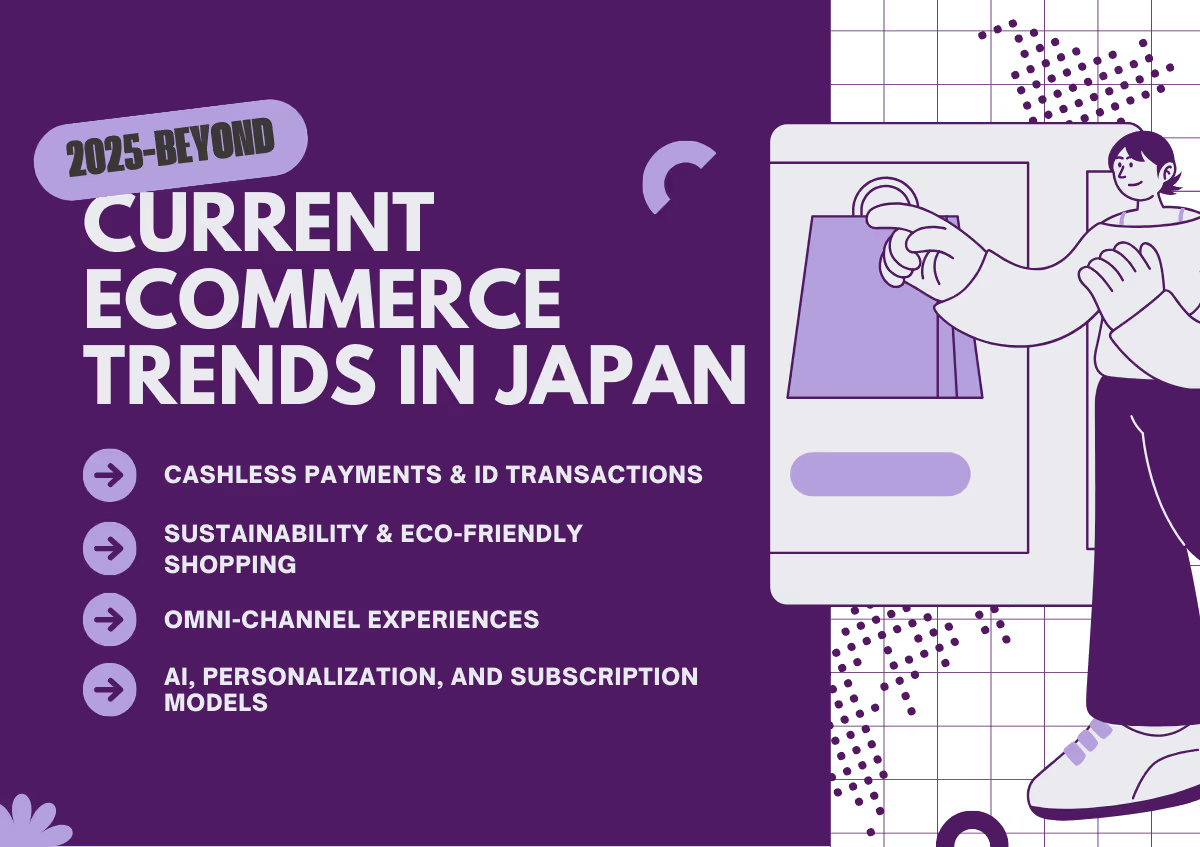
Japan’s e-commerce landscape is evolving rapidly, shaped by digital innovation, changing consumer behaviors, and broader economic shifts. While Japan has traditionally been slower to adopt specific global e-commerce trends, it is now accelerating in areas like cashless payments, mobile-first experiences, sustainability, and AI-powered personalization. Businesses that align with these emerging patterns will be well-positioned to thrive in this sophisticated but demanding market.
Cashless Payments & ID Transactions
For decades, Japan was known as a “cash-first” society—but that reputation is fading quickly. As of 2023, cashless transactions reached 126.7 trillion yen (~$885 billion), making up 39.3% of all consumer payments—just shy of the government’s target of 40% by 2025.
This transformation is fueled by:
- Smartphone payment apps like PayPay, LINE Pay, and Rakuten Pay
- Transit cards (Suica, PASMO) accepted at many retailers
- QR-code scanning for quick checkout
- In-app purchases for both physical and digital goods
- Digital wallets and recurring billing systems
Younger generations are leading this shift, but adoption among older consumers is also increasing due to the convenience of non-cash payments and government-backed rebate programs that incentivize them.
For international brands, offering localized payment options—especially QR-based apps and konbini pay (convenience store payment)—is essential. These methods enhance trust and provide familiarity in an otherwise foreign brand experience.
Sustainability & Eco-Friendly Shopping
Sustainability is becoming a core value among Japanese consumers—particularly among younger demographics and families.
Buyers are actively seeking products with:
- Minimal or recyclable packaging
- Ethical sourcing or “Made in Japan” manufacturing
- Reusable or durable design elements
This shift has influenced both marketing language and product offerings. In fashion, for instance, resale platforms like Mercari and clothing rental services like Mechakari have gained popularity. In household goods, brands that emphasize natural ingredients, cruelty-free practices, or biodegradable materials are seeing increased traction.
Retailers are also expected to reflect eco-conscious values in their operations—from carbon-reducing logistics to plastic-free shipping. For global sellers, communicating environmental commitments clearly (in Japanese) and incorporating visual eco-badges or certifications can improve conversion rates and brand trust.
Omni-Channel Experiences
In Japan, the online-to-offline (O2O) experience is more than just a convenience—it’s expected.
Major brands like Uniqlo and Muji have already mastered this approach:
- Customers can browse online, then reserve or pick up items in-store.
- Payment can be made via konbini pay after pickup, reinforcing trust and flexibility.
- Loyalty points and purchase history are often synced across both digital and physical stores.
Omni-channel strategies also include:
- LINE integration for real-time updates, promos, and digital receipts.
- Online returns at physical locations, making post-purchase support more accessible.
- In-store QR codes for ordering out-of-stock items.
This seamless flow between digital and physical retail is particularly effective in Japan’s dense urban centers, where shoppers value both in-person service and mobile convenience.
AI, Personalization, and Subscription Models
Japan’s e-commerce environment is increasingly powered by AI and predictive analytics, with more than half of B2C companies using or testing AI tools to enhance digital experiences.
Personalization in Practice:
- Product recommendations based on browsing history or seasonal demand
- AI-driven chatbots offering polite, real-time support in Japanese
- Dynamic pricing and real-time stock visibility
- Tailored promotions based on user behavior, loyalty status, or location
This technology isn’t just for large enterprises. Shopify and other SaaS platforms now offer built-in AI tools for SMEs, allowing smaller brands to create data-driven campaigns that feel localized and relevant.
The Subscription Boom:
Japan’s subscription market is projected to exceed 1 trillion yen (~$7 billion USD) by 2025, and the model is expanding well beyond digital media. Emerging subscription categories include:
While Japan offers a lucrative and well-developed e-commerce ecosystem, success here is far from guaranteed. For overseas businesses, understanding the barriers to entry and consumer expectations is just as important as identifying opportunities. Below are the key challenges that international companies must anticipate and address when entering the Japanese market.
Navigating Japan’s Complex Payment Preferences
Japan is undergoing a gradual transition toward cashless commerce, but cash still maintains a strong presence—particularly among older generations. Despite the growth of digital wallets like PayPay and LINE Pay, many consumers still prefer traditional methods such as cash-on-delivery (COD) and convenience store (konbini) payments.
Common Payment Challenges:
- Trust gap with digital payments: Unlike in China or South Korea, there’s lingering skepticism in Japan regarding digital security.
- Generational divides: Younger users prefer QR payments and credit cards, while older consumers still gravitate toward cash-based options.
- Cart abandonment: If a site lacks familiar payment methods, many shoppers will simply abandon their purchase.
Solution: Businesses must support multiple payment options—including COD, credit cards, PayPay, and konbini pay—to ensure a frictionless checkout experience for all user segments.
Meeting Exceptionally High Customer Expectations
Japan is known for its exceptional standards of customer service, often summarized by the saying “お客様は神様です” (The customer is God). While this dedication to service builds trust, it also puts immense pressure on businesses to perform flawlessly.
Key Expectations:
- Polite, timely support: Japanese customers expect near-instant responses and high levels of formality—especially via chat or email.
- Cultural localization: Promotions should align with local holidays (e.g., Golden Week, New Year, Obon) and be culturally resonant.
- Authentic social proof, including reviews, influencer endorsements, and third-party feedback, is essential for building trust.
- Fast and accurate delivery: Delays, vague tracking, or damaged packaging can seriously damage a brand’s reputation.
Solution: Offer fully localized customer service, incorporate native review systems, and use local logistics partners to meet delivery expectations. Localization should include both language and tone.
Balancing Mobile Optimization with an Aging Population
Japan has some of the highest smartphone penetration rates in the world, but mobile e-commerce still faces UX challenges, especially among older users. At the same time, Japan is one of the oldest societies globally, with a median age of 49 and about 10% of the population aged 80 or older.
Mobile vs. Age-Related Usability Issues:
- Over 40% of shoppers still complete purchases on desktop, citing frustration with mobile apps and mobile site navigation.
- Among older shoppers (60+), there are higher incidences of accidental subscriptions, duplicate purchases, and general confusion with checkout flows.
Solution: Invest in responsive mobile design that’s simple and accessible. Consider offering features like:
- Larger buttons
- Step-by-step checkout
- Clear confirmation screens
- "Easy mode" or accessibility toggle for older demographics
This dual-focus approach can improve both conversion rates and user satisfaction across age groups.
Financial Complexity in Multi-Generational Households
A unique demographic challenge in Japan is the high number of unmarried adults living with their parents—nearly 11.85 million people aged 20–39, representing about 10% of the total population.
This has created a dual dynamic:
- On one hand, young adults with fewer living expenses have more disposable income, fueling demand for lifestyle, fashion, electronics, and travel products.
- On the other hand, multi-generational homes, especially those with unemployed adult children or elderly caregivers, often face low-income constraints, limiting their discretionary spending.
Solution: Segment your audience with precision marketing:
- Use data and personalization to promote premium products to young, tech-savvy consumers.
- Simultaneously, offer value bundles, subscription models, or affordable alternatives to price-sensitive households.
Additionally, brands can find success in targeting aspirational values—promoting travel experiences, personal development, or curated lifestyle improvements that resonate with youth still living at home.
Japan’s E-Commerce Market: Future Trends and Outlook

Japan’s e-commerce market is entering a new phase—one that blends innovation with long-term digital maturity. According to ECDB, the market is expected to grow at a compound annual growth rate (CAGR) of 4.9%, reaching $159.5 billion USD by 2028. While not explosive, this steady growth underscores the country’s resilient consumer demand, strong logistics infrastructure, and ongoing digital adoption.
Key drivers behind this growth include the continued rise of mobile shopping, increased use of AI and automation, and the growing popularity of direct-to-consumer (DTC) and subscription-based business models. For global brands, this represents a critical moment to align with Japan’s evolving digital retail environment—or risk being left behind.
What’s Shaping the Market: 2025 and Beyond
Mobile Shopping as the Default
Mobile commerce now accounts for over half of e-commerce transactions in Japan. Brands like Rakuten, Amazon Japan, and PayPay Mall are investing heavily in mobile optimization, ensuring faster checkout, in-app rewards, and AI-driven recommendations.
As Japanese shoppers increasingly rely on their phones for everyday purchases, businesses must ensure that both apps and mobile websites are frictionless, responsive, and visually intuitive.
Did you know that Japanese commuters spend over an hour a day on public transit? This creates a prime window for mobile shopping behavior.
Direct-to-Consumer (DTC) Expansion
More brands are skipping third-party platforms and launching their own e-commerce sites in Japan. This DTC shift offers:
- Greater control over pricing and branding
- Direct access to customer data
- Loyalty-building through exclusive products and personalized experiences
DTC brands also benefit from building longer-term customer relationships in a market known for brand loyalty and high service expectations.
Rise of Subscription-Based Services
Japan’s subscription economy is booming, with the market expected to exceed 1 trillion yen (~$7 billion USD) by 2025. These services offer convenience, predictability, and value—all essential traits for time-conscious Japanese consumers.
Examples:
- PAL System – Organic food and meal kits delivered weekly
- Mechakari – Fashion rental for trend-conscious users
- Rentio – Short-term electronics and appliance rentals
- Kodomo Ehon – Monthly delivery of curated picture books for kids
Subscription models thrive because they cater to routine, personalization, and compact living needs—all deeply ingrained in Japanese life.
AI, Automation & Smart Commerce
AI is already transforming Japan’s e-commerce backend and customer experience:
- Personalized product suggestions
- Chatbots offering polite, real-time customer support
- Automated fulfillment and inventory optimization
Rakuten and other major players are utilizing AI to anticipate consumer needs and deliver personalized experiences, even adjusting product pages in real-time based on user behavior. These innovations reduce friction and enhance trust—two crucial factors for Japanese consumers.
Cross-Border E-Commerce on the Rise
Japanese consumers are increasingly showing interest in shopping internationally—especially for unique or hard-to-find items. Platforms like AliExpress have seen success, and more global brands are investing in:
- Localized websites with Japanese language support
- Japanese payment methods
- Culturally relevant promotions
The opportunity is clear, but so is the responsibility: brands must fully localize, not just translate.
How International Brands Can Stay Competitive
Japan’s market may seem dominated by large incumbents, but there’s room for innovation and niche positioning—especially for agile international brands that listen and adapt.
Key Strategies for 2025:
- Build trust through localized service, fast fulfillment, and native content.
- Embrace mobile as the first and often only shopping channel.
- Invest in AI and automation, even through low-code solutions.
- Test DTC or hybrid strategies, blending marketplace exposure with owned-channel intimacy.
- Collaborate with influencers who bring credibility, especially in the food, lifestyle, and fashion sectors.
A rising trend worth watching is the influence of YouTube creators and independent media personalities. These digital tastemakers are preserving cultural values while shaping purchasing behavior. In the food industry, for instance, creators promoting regional flavors and heritage cuisines have helped niche products gain national and even international traction.
Conclusion: Navigating the Unique Landscape of Japan E-Commerce Trends

Japan offers one of the most rewarding—but demanding—e-commerce environments in the world. With its blend of technological advancement and cultural nuance, the market doesn’t reward shortcuts. Instead, it values attention to detail, respect for the consumer, and a genuine commitment to localization.
As digital transformation continues to shape how Japanese consumers discover, purchase, and interact with brands, businesses must remain agile, informed, and culturally sensitive to stay competitive. Whether you’re launching on a major platform like Rakuten or developing a fully localized 自社サイト, the path to success starts with deep market knowledge and long-term commitment.
If you can deliver value while adapting to Japan’s high expectations, you’ll find that Japanese consumers are not only loyal—but powerful advocates for your brand.
Key Takeaways: Aligning with Japan’s Consumer Expectations
Entering Japan’s e-commerce market requires more than just translation—it demands accurate localization, strategic planning, and respect for consumer expectations. Here are the core insights to guide your approach:
- Japan ranks #4 globally in e-commerce revenue, but success depends on deep cultural understanding and technical adaptation.
- Mobile-first behavior is dominant, especially among younger consumers; yet, older users still shop online, requiring user-friendly designs across devices.
- The market is dominated by platforms such as Amazon Japan, Rakuten, and Yahoo! Shopping, each with its own ecosystem and user expectations.
- Cashless payments and QR wallets are gaining popularity, but cash-on-delivery and convenience store payments remain prevalent, especially among older consumers.
- Customer service expectations are incredibly high—fast replies, formal tone, and smooth returns are all expected.
- Emerging trends include AI personalization, subscription models, direct-to-consumer (DTC) channels, and eco-conscious shopping.
- Cross-border shopping is growing, but international brands must localize content, payment methods, and marketing strategies to succeed.
- Multi-generational households and urban lifestyles influence how and what Japanese people buy—marketers must plan for both aspirational and budget-conscious shoppers.
By aligning your strategy with these key factors, you can establish trust and relevance in a market that values long-term commitment and high-quality execution.
Ready to Enter the Japanese Market? Partner with IGNITE

At IGNITE, we specialize in helping international brands succeed in Japan’s highly nuanced digital landscape. Based in Osaka, our multilingual team of Japanese and foreign marketing experts delivers end-to-end digital solutions—from market research and localization to content creation, advertising, and web development.
Whether you're launching an e-commerce platform, optimizing for Japanese SEO, or running paid campaigns tailored to Japan’s cultural pulse, we’ve got you covered.
We localize. We scale. We deliver.
Let us IGNITE your brand’s success in Japan.










